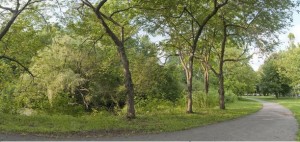http://www.wickedlocal.com/allston/fun/entertainment/arts/x684376767/Brighton-Allston-Heritage-Museum-hosts-its-first-arts-and-crafts-fair#axzz1ah7mJEte
Archive for the ‘Uncategorized’ Category
A slideshow of Fran Gardino’s work
Wednesday, December 15th, 2010Zoa Chimerum
Wednesday, December 15th, 2010Ian Hendersan is an unusual jeweler who makes his pieces from insulation tubing used for electrical wires.
Map of the Charles River
Wednesday, December 15th, 2010News-you-can-use-Slideshow: Charles River geese run afoul of the DCR
Tuesday, December 14th, 2010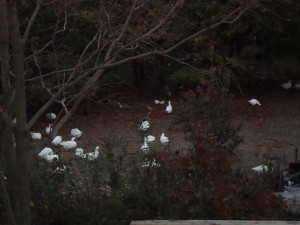
The goose meadow at the corner of the on the banks of the Charles River at the corner of the B.U. Bridge is in danger of being destroyed by the Department of Conservation and Recreation.
Click on this link to see : http://archive.rhynewservice.com/slideshows/USE-101120-Urban_Wilds/
Where have all the trees gone?
Tuesday, December 14th, 2010In August 2009, the Department of Recreation and Conservation formerly announced that they would be removing 157 old or diseased trees from Memorial Drive as well as a select number of other trees in order to make room for the Boston University Bridge rehabilitation project and to restore landscape between the B.U. Bridge and the Longfellow Bridge. The DCR also said they would be removing nine healthy trees from the goose meadow. At the time, this announcement was met with furious opposition from an environmental group in Boston. The group, Friends of the Charles River White Geese, was convinced that 157 was a whitewashed figure and the DCR would end up removing up to 600 trees, most of them healthy, in order to complete their B.U. Bridge project. Member and local environmentalist Marilyn Wellons called the whole thing ‘just outrageous’. Wellons and the Friends of the Charles River White Geese have been at loggerheads with the DCR for several years now; in fact, the group was formed to protect the Charles River geese from the DCR.
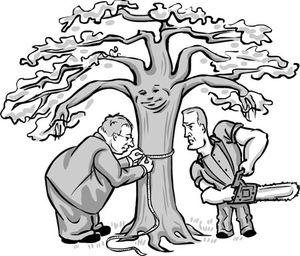
“The DCR removed a thicket of blackberry brambles from the goose meadow saying it was ‘an invasive species’ and now the geese don’t have enough to eat” Wellons said. “I’m sure they’ll end up cutting down lots and lots of trees.” The Charles River Conservancy (CRC) supported the DCR and said on its website, “Chopping down trees has and will always be an emotional issue, but in this case it’s the right choice.”
Earlier this year, the DCR cut down twelve splendid, ancient trees, near the goose meadow saying they were in the ‘wrong location.’ According to Bob La Trémouille from the Friends of the White Geese, they are slowly cutting down more trees under the nonsensical excuse of ‘vegetation management.’ Representatives from the DCR insist that they are removing only old or diseased trees that may fall at any time and are a hazard. However it begs the question, how is it that all the trees that need to be cleared for the B.U. Bridge project, diseased or old?
The DCR and the CRC, (which, incidentally works in partnership with the DCR) promised that every tree that was removed would be replaced with saplings. However, this has not happened yet. In a phone interview, CRC Volunteer Coordinator Logan Walsh said that the most recent tree planting carried out by the CRC was in mid- October when around eight London Plane saplings were planted along Memorial Drive.
Saving Trees
Tuesday, December 14th, 2010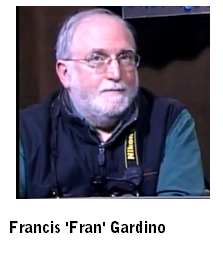
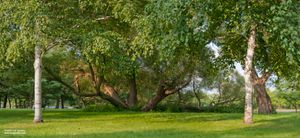
This huge tree near Herter reminded Gardino of the Akira Kurosawa’s movie ‘Ran’, a Japanese retelling of King Lear.
Francis Gardino, 58, has been an artist since he was three. Today, he is one of Boston’s most well-known and respected photographers. He has been interviewed on local television and radio channels several times and his work can be found displayed in some of Boston’s most important buildings, like Logan Airport and the Charles River Conservancy.
Gardino is best known for his beautiful, sweeping shots of Boston and its surroundings. “I go out and look, and try to see things from a different angle, a little differently from other people,” he said. He finds beautiful scenes that we miss, that are right under our noses and he portrays them through his images.
One of Gardino’s favorite locations is the Charles River. “I’ve lived in Brighton for 22 years and drive up and down the river on a daily basis.” Gardino started work on his Charles River collection around seven years ago. Now, he has created a beautiful series of images featuring the Esplanade with the Hatch Shell and the Community Boating Inc. club, Herter Park, the stretch in Cambridge with over a hundred old Sycamore trees, and Soldiers Field Road across from Harvard Stadium.
In August 2009, the Department of Conservation and Recreation (DCR) officially announced their intention to remove approximately 160 dead, old or diseased along Memorial Drive. “This prompted me to do more work. The trees have such character; I want to remember them the way they were,” Gardino said. It was a fortunate decision. Earlier this year, a massive windstorm destroyed many trees and blew down tree limbs along the Charles River--- some of which had served as Gardino’s favorite subjects.
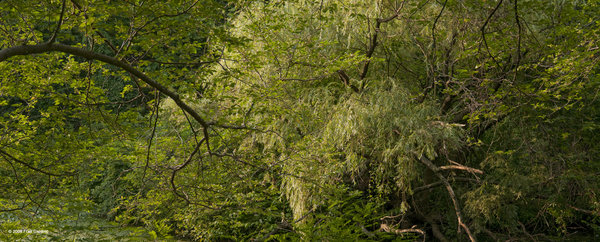
Many trees may be a couple of hundred years old. Gardino has seen these willows, ash trees, maples, sycamores and oaks since childhood, when he would try to climb them. His father, Leo Gardino had been a commercial artist. Three-year-old Fran often went up to his father’s attic studio and sat on the floor with coloring pencils and a sheet of paper. Gardino’s father also did some paintings of the Charles River, which was another factor that drew him to it. Gardino attended Massachusetts College of Art where he studied fine arts, painting and photography. “Some of my scenes were also probably inspired by the paintings of Thomas Eakins,” he said. “I went to see a show of his work 20 years ago.” He graduated in the early 1970s with a B.A. in painting. Initially he thought he was going to follow his father’s footsteps and become a commercial artist. “But my composition was terrible,” Gardino said. “This was why I took so many photography courses, to help with composition and technical aspects.”

Gardino enjoys taking photographs far more than painting, especially today, when there are so many imaging editing software available. He combines his knowledge of photography and painting, applying some of aspects he learned about painting. “I take several photographs and stich them together using ‘merge’ on Adobe Photoshop,” Gardino explained. “I try to get as many pixels as possible, because I want to print big and have people be able to walk into them.” Gardino then prints his completed images on canvas. “Previously, you had to have a big camera to do panoramic photographs, but now I can do it in pieces.”
Gardino’s panoramic photographs are enormous; the one that hangs in Terminal A of Logan Airport, ‘Coach Class Sunrise’, is a 10 foot by 30 foot photograph of white clouds at dawn. Several of his Charles River shots have similar dimensions. They also have interesting names ranging from ‘Ophelia’s Madness’ to ‘You Got Me’ and ‘I’m Goin’ Down’. All three have indeed ‘gone down’ courtesy of the DCR or the windstorm.
The use of Shakespearean names (or the names of tragic Shakespearean characters that ended up dead) is a hat tip to the Publick Theatre at Herter Park, which often puts on Shakespeare. In Gardino’s gallery, ‘Ophelia’s Madness’ is accompanied by ‘King Lear’ (a formidable looking tree, split into three trunks) and a wide, sweeping shot called ‘Polonius under a Curtain of Brush’. “That’s because Polonius was killed behind a curtain.” Gardino said.
Now, Gardino has started work on winter scenes. “I’m just trying to catch the passage of time,” he said.
Allston-Brighton’s Memorials get a cleaning for Veteran’s Day
Monday, November 22nd, 2010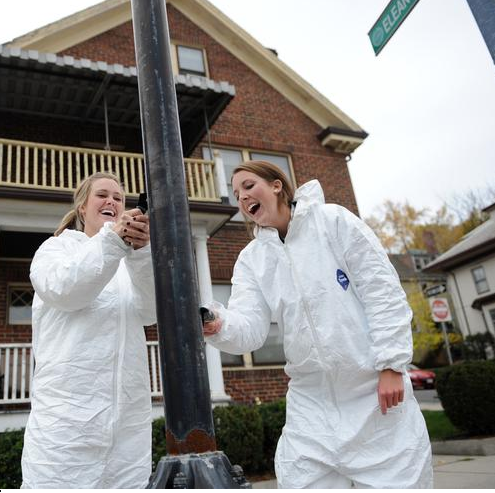
There’s something different about Allston-Brighton. The irksome graffiti tags are gone (even the ones high up on the sign posts), the sidewalks are litter free and clear of rotting leaves and Allston-Brighton’s parks and monuments are immaculate.
A group of 40 individuals took part in cleaning up, in some cases repainting and repairing, Allston-Brighton’s memorials in honor of Veterans Day.
This crew consisted of Boston College students, Brighton High School ROTC students, District 14 police officers, people from the Public Works Department and politicians such as Councilor Mark Ciommo and Rep. Kevin Honan.
“We’re trying to get the Allston village area cleaned up, it’s an artist’s community and should be aboutart, not graffiti,” said Sergeant O’Hara. “The graffiti was wreaking havoc, lowering the price of housing, just making it look like nobody gave the area any tender loving care. In the overall scheme of things, if the area looks nice, people feel good about it and crime is a little less,”
Everyone gathered at the Veronica Smith Senior Center on Saturday morning, divided into groups of seven or eight and set off to work on their assigned spots. These included the Old South Meeting House in front of the District 14 Police Station, the Veteran’s Memorial statue in Jackson Square at the intersection of Chestnut Hill Avenue and Winship Street, Cunningham Park at the intersection of Sparhawk Street and Cambridge Street, and the New England Holocaust Memorial on Union Street.
The Boston College Neighborhood Center, an organization that encourages positive ties between the college and the community, has been organizing fall clean up drives for many years.
Millie Hollum-McLaughlin, director of the Veronica Smith Senior Center, said, “We’ve hosted the BC cleanup day for many years, but this is the first time so many different groups got involved. It’s a total community effort.”
The BC kids were part of a group called the Appalachia Volunteers.
“We have a ton of kinds in the group,” said senior Andrew Mccue. “It was great to do this for Veteran’s Day. Our group must have collected nine or ten bags of trash.”
One group walked all the way from Sparhawks Street to Allston, cleaning up flyers and stickers and repainting poles and electric boxes.
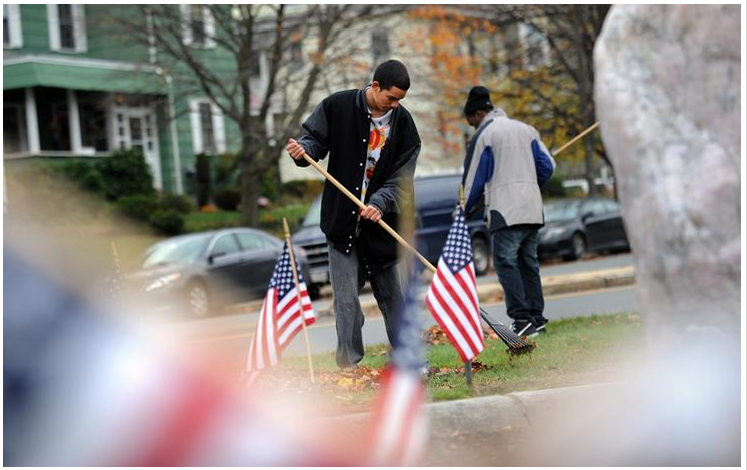
“We used those long paint rollers and wore big white suits and gloves,” said Molly Foley, a BC sophomore.
“You’ll be surprised at how much graffiti they can get in bizarre places,” said Mark Handley from Ciommo’s office. “We usually run an annual program called ‘Fight the Blight’ during the summer which is a big graffiti cleanup, but we decided to do something special for Veteran’s Day.”
Ciommo and Honan were at the Union Street memorial, which they had cleaned and decorated with American flags.
“This was like a last massive cleanup before the weather turned really bad,” said Ciommo. “This is the first year we’ve put everyone together and made a collaborative effort, to really make an impact.”
“Doing it again next year seems like a great idea,” said Honan. “We do ‘Boston Shines’ in spring and this is a good fall cleaning.”
Election Night Live: Charlie Baker
Monday, November 1st, 2010
Here's our live blog from the House of Blues, the venue of Republican candidate Charlie Baker's after party.
The Geese of Magazine Beach
Monday, October 25th, 2010
For more than 20 years, the banks of the Charles River have been home to a large flock
of geese. A flock, which, over the years has tragically reduced in number because of a
series of man-made fiascos and deliberate attacks.
The present nesting area of the Charles River white geese is at the corner of the Boston
University Bridge and the eastbound Memorial Drive. It is an open space the size of a
small baseball pitch beside the river. It serves as a home to around eighty beautiful white
and brown geese, ducks, swans and other urban wildlife. The geese are tall, majestic and
very tame.
The original flock was brought to live at the Cambridge branch of the Massachusetts
Water Resources Authority in 1970s. They acted as guards, alerting workers to
trespassers. When their services were no longer required, they went to live on the banks
of the river.
“ There are three basic breeds,” said Bob La Trémouille, 67, an environmental activist and
a lawyer. “ They’ re White China, Emden and Toulose geese. But there’ re been so much
intermixing that they’ re all hybrids now.”
During mating season, a number of females can be spotted sitting on nests
hidden behind the mossy maples and oaks or camouflaged in the knee length brown
grass. The area used to be a dense,
wild thicket with dandelions, weeds and blackberry brambles. But authorities have been
clearing out the foliage as part of a larger project of beautifying the riverbank.
“ We used to have a beautiful green meadow with an excellent variety of plants and
animals, but BU and the Department of Conservation and Recreation (DCR) destroyed
it,” said La Trémouille. La Trémouille and Marilyn Wellons, a resident of Cambridge
are co-chairs of Friends of the White Geese, a non-profit organized in 2000 to protect
the environment on the Charles River. They have been spearheading the campaign to
save the geese. “ The DCR routinely, twice a year since 1999, destroy vegetation which
is needed for migrating waterfowl, except for a bizarre wall of introduced vegetation that
was put in at Magazine Beach in 2004.,” said La Trémouille
Magazine Beach, which lies just west of the BU Bridge on the Cambridge side of the
river, was the geese’ s original home. The DCR’ s introduced vegetation had considerable
difficulty surviving because it was not indigenous to the Charles River. “ It kept dying
on them at first,” said La Trémouille. “ It has since grown into a wall which has kept the
geese from feeding there.”
Geese are vegetarian and ordinarily their main food is grass and weeds. Since the
vegetation in their environment was destroyed, the geese received food from
local charities and supermarkets like Trader Joe’ s and Harvest.
In 2004, the Charles River Urban Wilds Initiative, Inc was formed. CRUWI, headed by
Bill Naumann, is the tax-exempt organization feeding the Charles River White Geese
and other needy animals. Bill Naumann, a Cambridge-based independent business and
financial consultant, and his wife Allison Blyler, a creative writing instructor at Boston
University feed the geese twice every day.
“ They eat cracked corn, oats, bread and greens,” said Marilyn Wellons.
There are white boxes containing remnants of grains and lettuce hidden in the grass. The
geese have been helping themselves. This meadow, bordered by the Charles River on
one side and graffitied, concrete embankments on the other three, has become a suitable
enclosure for the geese, ducks, migrating swans and other waterfowl. Unfortunately,
according to the Friends of The White Geese, they are in danger of losing this home too.
“ The DCR’ s plans to repair the BU Bridge include a "rehabilitation" of the storm water
system,” said Wellons. “ If it goes through, it will destroy the surrounding environment.
However, this "rehabilitation" actually increases its footprint--the area of ground it
covers--rather than conform to the existing one.”
Friends of the White Geese has been working to save the geese for a decade.
“ The damage that has been inflicted on their habitat is outrageous,” said La
Trémouille “ In Fall 2008 the DCR dug up Magazine Beach to put in playing fields. They
don’ t like natural maintenance, they like fertilizer maintenance, which will, of course
poison the animals.”
La Trémouille knows some of the geese by their whimsical names such as Brown Beauty,
Pinky and Little Gray, but says that because he has not been the one feeding them since
CRUWI was formed, he lost track. “ The females are smaller,” he said, pointing to one
sitting on a nest made of dry leaves and feathers. “ They tend to
have bald spots on the back of their neck. That is part of the mating; the male gets on top
and pecks the back of her head.”
When asked what the DCR wanted to do with the goose meadow, La Trémouille said
they wanted to turn it into a park. “ They’ re offended by nature,” h said emphatically.
The banks of the Charles River provide a window into the urban wild. “ We have every
intention of protecting the Charles River white geese and other wildlife currently being
starved by state and local governments,” said La Trémouille.
